Your building’s fire safety infrastructure is only effective if people on the premises understand what to do and where to go in the event of an emergency. This is why fire safety signage is an essential aspect of any business owner’s health and safety responsibilities.
Yet, with several categories of fire safety sign available, as well as specific requirements on where they should be installed, getting it right can be a challenge.
In this post, we explain the different types of fire safety sign, which ones you’ll need according to UK fire regulations, and where they should go to ensure safety and compliance.
Fire safety signage in UK regulations
There are two primary pieces of safety legislation covering the proper selection and use of fire safety signs in a commercial building:
- The Regulatory Reform (Fire Safety) Order 2005)
- The Health and Safety (Safety Signs and Signals) Regulations 1996
As the title suggests, the Regulatory Reform (Fire Safety) Order 2005 (also known as RRO) is the main governing documentation for fire safety in the UK, combining all fire safety laws into a single, comprehensive order.
The Health and Safety (Safety Signs and Signals) Regulations 1996 – again, as the title suggests – lay out laws relating specifically to safety signage, including fire safety signs.
Categories of fire safety signs – and whether you need them
There are five main types of fire safety sign, each with a different application:
- Fire action notices
- Safe condition signs
- Fire equipment signs
- Fire warning signs
- Prohibition signs
1. Fire action notices
The job of fire action notices is to tell people on-site what to do in case of a fire. They offer a step-by-step guide of appropriate actions and may feature small blank spaces so you can add custom details, such as your building’s fire assembly point or a designated member of staff responsible for calling the emergency services.
Fire action notices are often blue/white, but frequently combined with other colours/shapes for comprehensive instructions.
They’re designed to be as clear as possible while providing enough detail that even those who are unfamiliar with the premises can take the required action swiftly and safely.
Fire safety notices aren’t all identical; you should choose one that is most appropriate for your building and operations. Below is a fairly standard example:
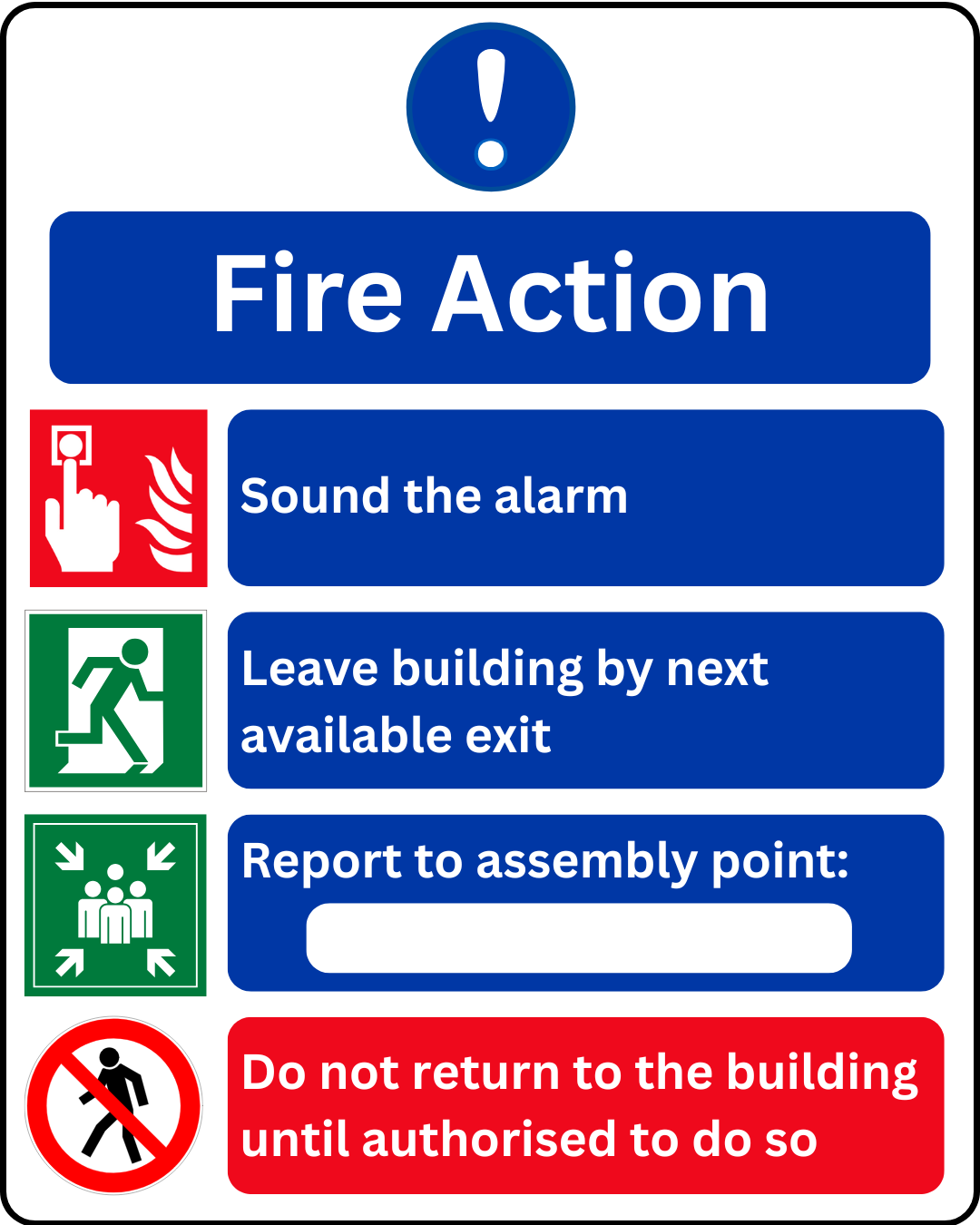
Do you need a fire action notice?
All commercial buildings, regardless of size or use, must have a fire action notice in place.
Where should fire action notices be installed?
Best practice dictates that fire action notices should be placed beside all fire alarm call-points and final exit doors.
This is because these are the points occupants are most likely to approach during an emergency — either to raise the alarm or to leave the building. Positioning the notices here ensures they are immediately visible at moments when clear instruction is most needed, helping people understand what action to take, which exit routes to use, and where to assemble once outside.
2. Safe condition signs
Safe condition signs indicate safe routes, exits, and locations of safety, such as emergency escape routes, first aid points, and fire assembly points. They are typically green with white pictograms and/or text, in accordance with BS EN ISO 7010 and BS 5499 standards. Although, fire door safe condition signs may be blue and white isntead.
They’re designed to guide occupants to safety during an emergency, showing the direction of travel or location where people should gather once evacuated.
There are three main types of safe condition signs for fires:
- Fire exit signs
- Fire door signs
- Fire assembly point signs
Related: Fire escape regulations – A guide for UK businesses
1. Fire exit signs
Fire exit signs help building occupants locate and follow the correct escape route to the nearest safe exit in the event of a fire. They typically show the classic exit pictogram alongside an arrow to guide the direction of escape.
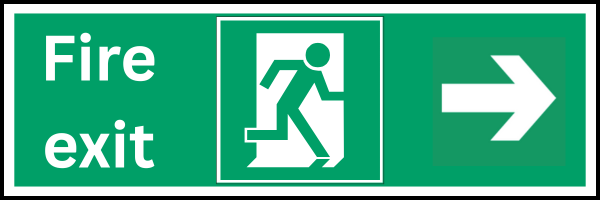
Do you need a fire exit sign?
Fire exit signs are not strictly mandatory if the Responsible Person’s risk assessment clearly justifies their omission in a simple, low-occupancy building.
However, in nearly all non-domestic premises, particularly those where people are unfamiliar with the layout, signs will be necessary to meet the RRO requirement that “Emergency routes and exits must be indicated by signs.”
Where should fire exit signs be installed?
Fire exit signs can be mounted on walls, above doors, or can even be suspended from ceilings. They should be fitted a minimum 1.8 metres above floor level, and it’s best if all mount heights are consistent throughout the building to make evacuation as simple as possible.
Depending on the size and layout of your commercial property, you may need to use multiple fire exit signs with arrows pointing in different directions to effectively lead occupants through the nearest fire exit route.
There are three golden rules of fire exit sign placement:
- If a building requires fire exit signs, there should be at least one visible to all occupants no matter where they are within the structure.
- They should be installed above head height so everyone can see them in the event of an emergency.
- Someone using the signs should always be able to see the next in sequence in order to evacuate in a timely and safe fashion.
2. Fire door signs
Fire door signs are simple notices that must be fitted on every fire exit door in the building. They communicate that the door in question is a “fire exit” or “fire door” and that it should be kept clear or shut, depending on the specific requirements of the door in your building.
“Keep shut” variants are for fire doors that must be closed to stop fire and smoke from travelling through the building. The “keep clear” variant is also necessary for fire exit doors, if a fire door is automatically opening and closing, or if the path is likely to become blocked without the warning in place.
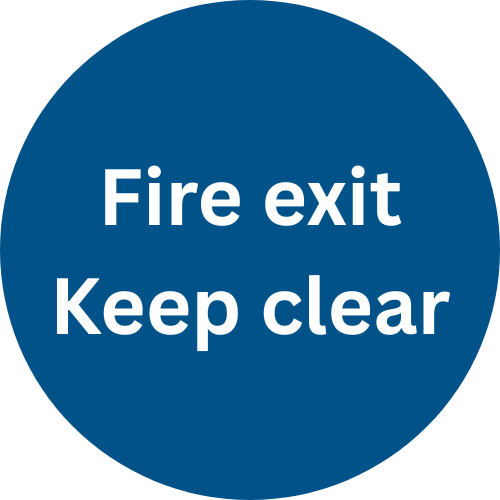
Text may differ slightly between signs. For instance, instead of saying “Fire door | keep shut”, one might specify that the door should be kept “locked shut”, or specify that the door is automatic. You’ll need to choose the most accurate sign for each fire door in your building.
You may also need to use additional signs that explain how a fire exit door or internal fire door is operated, to ensure people can escape with ease, even in panicked states.
For example, a fire door with a bar or pad handle will require one of the following:
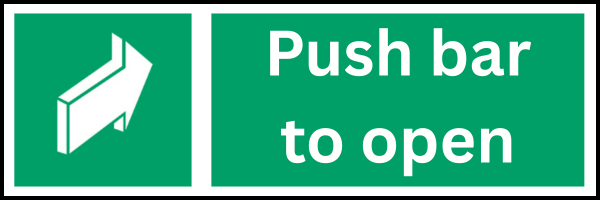
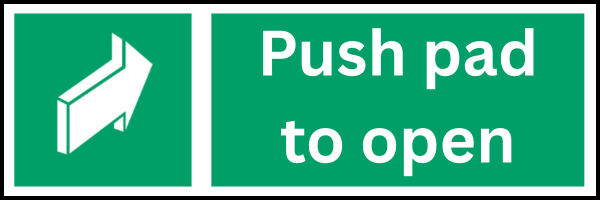
For doors opened via rotating handles, you’ll need to communicate which way people should turn the handle to escape, e.g.:
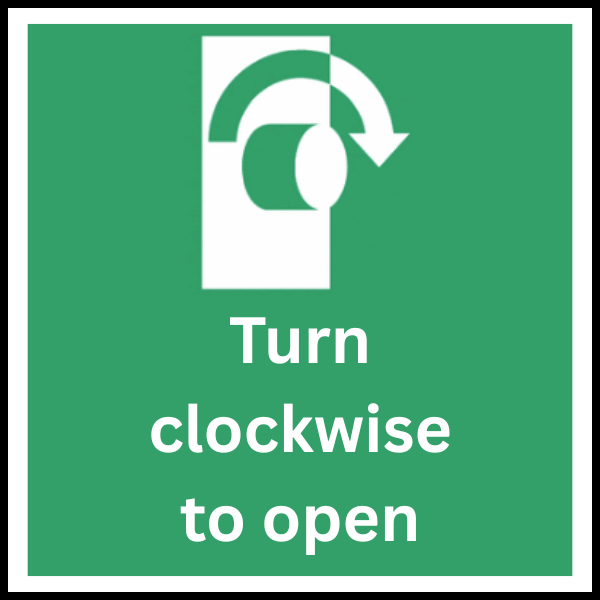
Do you need fire door signs?
UK fire safety regulations mandate that any and all fire doors in a commercial building must be signed appropriately. If you’re unsure how to select the correct signs for each of your fire doors, a Fire Risk Assessment from Cardinus will bring the clarity you need. Get a quote.
Where should fire door signs be installed?
Fire door signs need to be mounted at eye level on both sides of the fire door. This tends to be between 1.5 and 2 metres from floor level. They must be clearly visible – unobstructed by decorations, fixtures or other objects.
Fire door signs can differ to better guide usage of individual doors, but it’s best to keep the general design as consistent as possible across the premises.
3. Fire assembly point signs
Being that fire assembly points need to be a safe distance from the building and out of the way of emergency services, they may not be an obvious location for people fleeing a fire. This is why clear signage is essential.
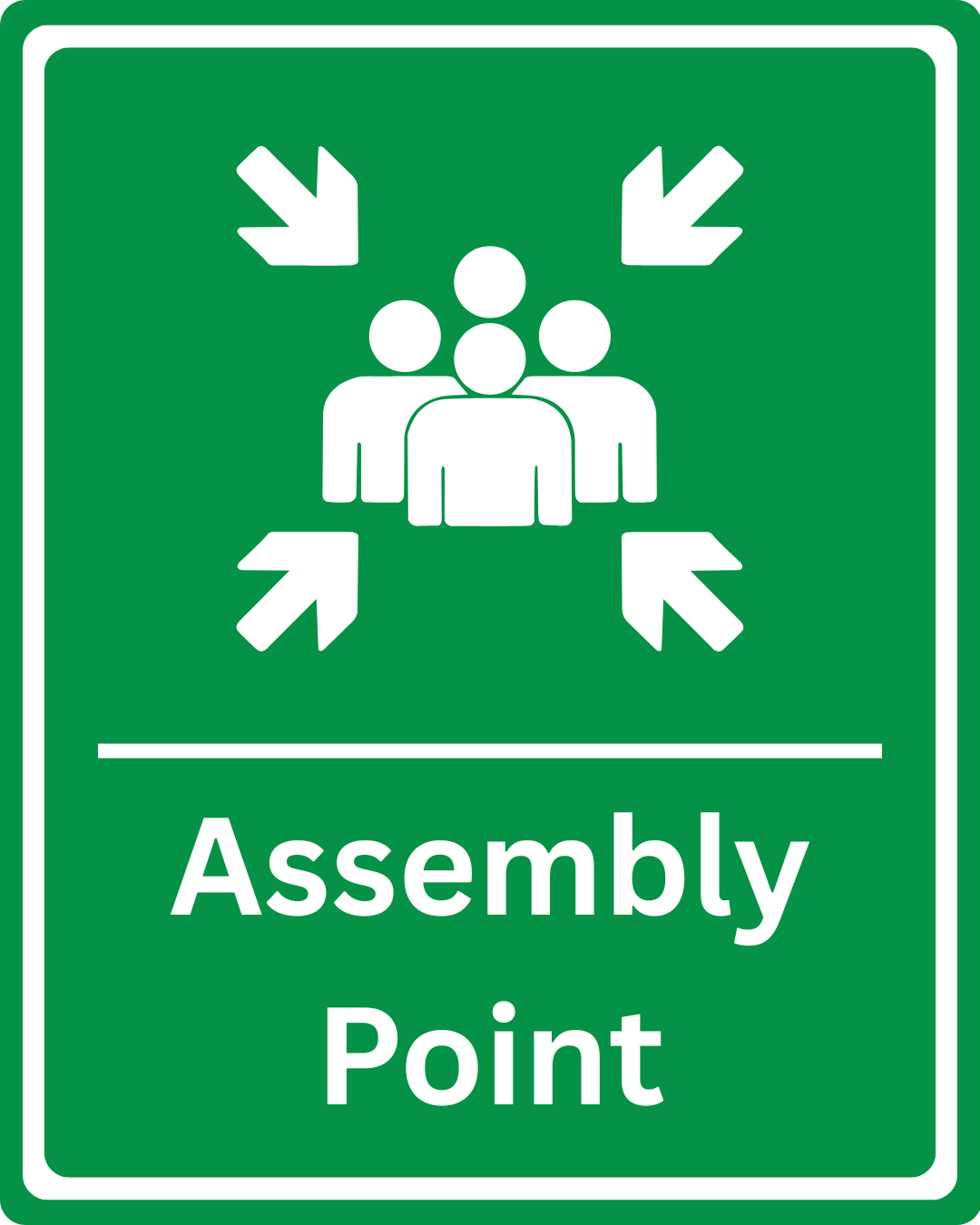
For larger buildings with multiple assembly points, it’s important to label them accordingly using signage.
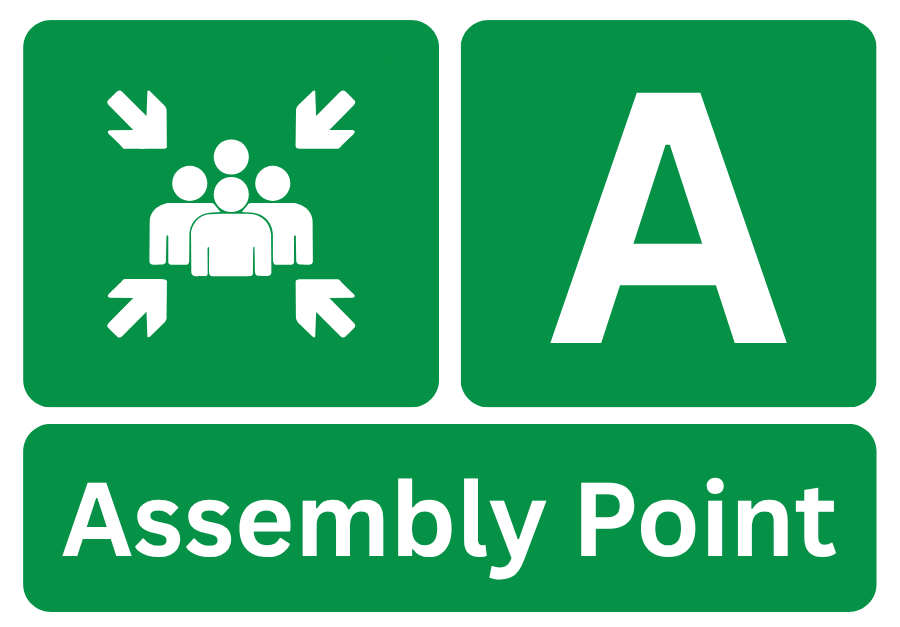
Do you need fire assembly point signs?
As all commercial buildings must designate a fire assembly point as part of a fire evacuation plan, you’re also required by law to ensure that these areas are clearly marked so people can easily find them in the event of a fire emergency.
Where should fire assembly signs be installed?
Fire assembly point signs should be mounted just above head height somewhere in the assembly area that will be most visible to people as they exit the building.
3. Fire equipment signs
Fire equipment signs show the location and type of equipment that can be used to respond to a fire, whether that be sounding the alarm or fighting the fire.
There are three main types of fire equipment signs:
- Fire alarm call point signs
- Fire extinguisher ID signs
- Non-extinguisher equipment signs
1. Fire alarm call point signs
Perhaps the most essential of the fire equipment signs is the one that shows occupants where to raise the alarm and kick-start the premises-wide fire emergency response.
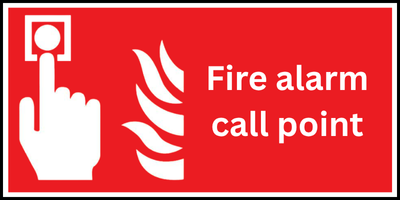
Do you need a fire alarm call point sign?
If you have a fire alarm installed in your commercial building (whether wireless or conventional), then yes; fire alarm call point signs are mandatory. But not all commercial buildings are required by law to use a fire alarm system.
The regulations stipulate that all business premises must have ‘an appropriate fire detection system’. This means that if there is a suitable alternative, you’re free to use it – and therefore would not need a fire alarm call point sign.
Where should a fire alarm call point sign be installed?
A fire alarm call point sign should be placed directly above or adjacent to the call point it identifies. It should be prominent and unobstructed.
Mount height typically falls between 1.7 and 2 metres off the ground.
2. Fire extinguisher ID signs
There are several different types of fire extinguishers, each designed to combat between 1 and 3 classes of fire.
Not only are some extinguishers ineffective for combating certain fire classes, but they may actually make them worse. Fire extinguisher ID signs ensure the user knows exactly what type of fire extinguisher it is, as well as safe and dangerous applications.
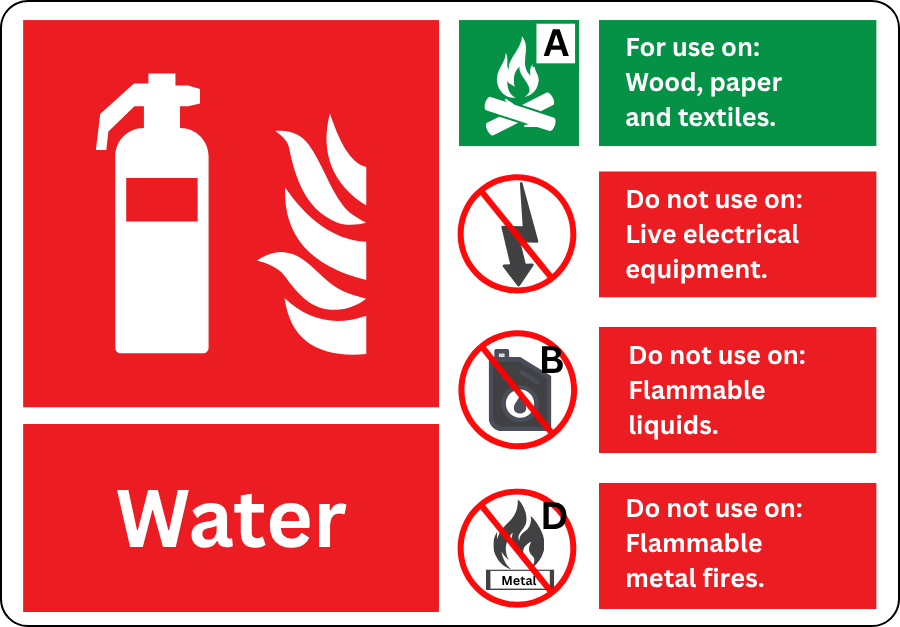 Do you need fire extinguisher ID signs?
Do you need fire extinguisher ID signs?
Fire extinguishers are mandatory in commercial properties, and UK regulations state that all fire equipment must be clearly identified, with fire symbols displayed at fire points. For fire extinguishers, fire extinguisher ID signs are the most effective way to meet these requirements.
Where should fire extinguisher ID signs be installed?
Fire extinguisher ID signs should be mounted above or adjacent to the extinguisher they’re identifying. The ideal height to ensure visibility from the approach route is between 1.7 and 2 metres.
3. Non-extinguisher equipment signs
Some commercial properties might also contain crucial fire fighting facilities beyond fire extinguishers, such as fire hose reels and dry risers. These should also be clearly signposted.
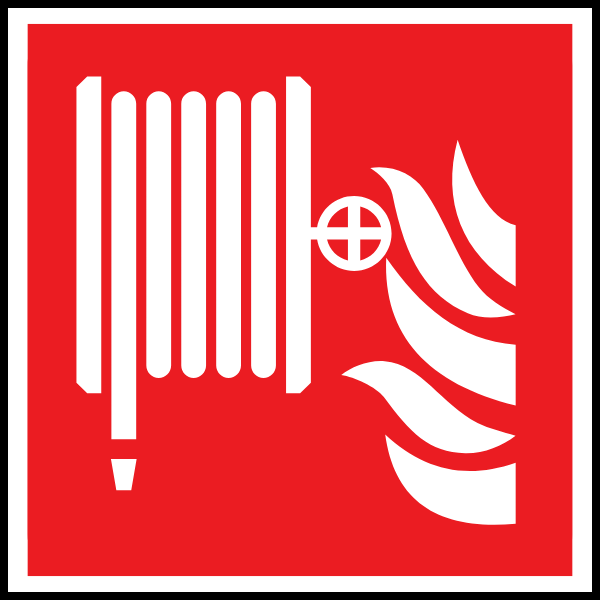
Do you need fire equipment signs?
If you have essential fire equipment on the premises, the regulations state that it must be clearly labelled, so appropriate signage is required by law.
4. Fire warning signs
Fire warning signs are triangular and almost always yellow with black pictograms, text, and borders, distinguishing them from green and red response-based signs.
Warning signs caution those in the building of a nearby fire hazard, such as flammable gas, liquid, or other highly flammable materials.
Do you need fire warning signs?
If there are fire hazards present in your commercial building, you are required by law to ensure that signage sufficiently communicates the danger to occupants.
Where should fire warning signs be installed?
Fire warning signs should be installed close to the hazards in question, in an unobstructed position.
5. Fire prohibition signs
Prohibition signs tell occupants what not to do, the most well-known perhaps being the no smoking sign. They’re circular with a red border and a red horizontal line spanning a black pictogram.
If there are multiple restrictions in a single location within the building, these signs can be combined into a single notice to quickly relay all essential information from one sign.
Warning signs and prohibition signs may also be merged into unified notices, with the yellow and black warning given top billing on the design, followed by the restrictions.
Do you need fire prohibition signs?
If there are fire hazards present in or around your commercial building, it’s likely that you’ll need to install prohibition signs alongside warning signs (or combined with them) to ensure a suitable level of awareness and safety among occupants.
Plan your fire safety signage with Cardinus
There’s a lot to consider when planning your fire safety signage, and the appropriate action may not always be clear – but a Fire Risk Assessment from Cardinus can help.
Guidance on the most appropriate signs for all fire safety-related aspects of your property are included in our assessment reports, so you can rest assured that you’ll get it right, be compliant, and protect the people that frequent your premises.
Learn more about our Non-Desctructive Fire Risk Assessments, our Destructive Fire Risk Assessments – or contact the team today to discuss your requirements.


